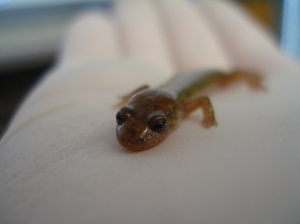When we think of jumping, we think of using our legs to do it. This is true in most mammals and lizards. However, salamanders (and some fish) have limbs that are underdeveloped for jumping (most have limbs that are relatively small and weak). Lungless salamanders (Plethodontidae) have a unique mechanism of jumping that does NOT use their legs for propulsion into the air. My interest is to understand how this mechanism works. During my undergraduate and masters research, I studied this mechanism.
 Plethodontid salamanders have been observed to jump using a unique mechanism in which they bend and unbend their torsos laterally with such force that they hurl themselves into the air. The salamander bends its body into a C-shape and then pushes that bend into the hips (think of a wave caused by moving a stretched out slinky from side to side). As the wave moves through the hips, they rotate; this rotation pulls on the ipsilateral (to the bend) hind limb, which is planted in front of the hip. Because the movement of the hip is away from the planted foot and the foot is anchored to the ground, the hip rotates towards the foot at such speed (17 body lengths a second!) that it catapults the salamander over the planted foot, achieving liftoff.
Plethodontid salamanders have been observed to jump using a unique mechanism in which they bend and unbend their torsos laterally with such force that they hurl themselves into the air. The salamander bends its body into a C-shape and then pushes that bend into the hips (think of a wave caused by moving a stretched out slinky from side to side). As the wave moves through the hips, they rotate; this rotation pulls on the ipsilateral (to the bend) hind limb, which is planted in front of the hip. Because the movement of the hip is away from the planted foot and the foot is anchored to the ground, the hip rotates towards the foot at such speed (17 body lengths a second!) that it catapults the salamander over the planted foot, achieving liftoff.
Consider rock climbing: you reach way over your head and grab a ledge. At this point, your shoulders are not lined up because of the arm stretch. If you bring your free hand’s shoulder to the level of the anchored shoulder, you will raise your body. The salamander jump works the same way, except this happens so quickly that it throws the salamander over the planted foot. Due to the importance of hip rotation to the performance of the jump, I call this mechanism “The Hip-Twist Jump”. More info on the early work jump biomechanics, and jumping after tail loss.
-Filmed at 500Hz
Other Questions
Some fish can actively modulate torso stiffness with their axial muscles… can salamanders? We work with a genus of Plethodontidae that live most of their life on the ground under rocks and debris. Some Plethdontidae live in trees, and thus have very different limb and tail structures…do these critters jump? In the same way?

Great “salamander” work, Real Science in Action. There is something quite similar here to a maneuver used in body-surfing to propel under water through the thickness of a huge (10′ plus) cresting wave to emerge from its face. Wearing a pair of fins, keep your feet together and kick dolphin-style, linking neck and torso tension with leg and hip strength and motion. There is a critical if slight hip side-to-side motion, timed to the up and down motion of the two-fin kick, that is needed to maximize the fin push. This in turn makes your shoulder girdle twist in time with your hip motion. Combined, this creates a tight spiral motion in the direction of travel, like “cork-screwing” through the water. The result is greatly reduced drag compared to a normal swimming stroke, and “drills” through the wave’s enormous uplift. As you emerge, you “wind-mill” both arms up and over your head and back down to your sides, a motion that in effect makes you leap out from the wave face leaving only from your knees down in the water. Drag one hand at that point, and you shoot sideways down the face. This is a technique I learned from a Hawaiian friend way back in college days, who attempted to teach me the basics of large-wave body surfing during winter storms off the CA coast. He said it was how dolphins surfed big waves … It was absolutely exhilarating and exhausting, and would probably give me a heart attack now … Hope my thoughts help in some way.